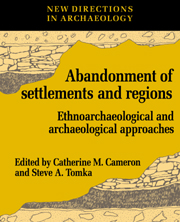Book contents
- Frontmatter
- Contents
- List of figures
- List of tables
- List of contributors
- Acknowledgments
- PART I INTRODUCTION
- PART II REGIONAL ABANDONMENT PROCESSES: ETHNOARCHAEOLOGICAL CASES
- PART III REGIONAL ABANDONMENT PROCESSES: ARCHAEOLOGICAL CASES
- PART IV ABANDONMENT PROCESSES WITHIN SITES: ETHNOARCHAEOLOGICAL CASES
- PART V ABANDONMENT PROCESSES WITHIN SITES: ARCHAEOLOGICAL CASES
- PART VI CONCLUSIONS
- 15 Understanding abandonment processes: summary and remaining concerns
- Index
15 - Understanding abandonment processes: summary and remaining concerns
Published online by Cambridge University Press: 23 May 2010
- Frontmatter
- Contents
- List of figures
- List of tables
- List of contributors
- Acknowledgments
- PART I INTRODUCTION
- PART II REGIONAL ABANDONMENT PROCESSES: ETHNOARCHAEOLOGICAL CASES
- PART III REGIONAL ABANDONMENT PROCESSES: ARCHAEOLOGICAL CASES
- PART IV ABANDONMENT PROCESSES WITHIN SITES: ETHNOARCHAEOLOGICAL CASES
- PART V ABANDONMENT PROCESSES WITHIN SITES: ARCHAEOLOGICAL CASES
- PART VI CONCLUSIONS
- 15 Understanding abandonment processes: summary and remaining concerns
- Index
Summary
Introduction
Whether one sees abandonment processes as transforming the material record (e.g. Schiffer 1983, 1985), or as integral components of site formation (e.g. Binford 1981), all archaeologically recovered remains have been conditioned by abandonment processes. It should not come as a surprise that, whether the examples of abandonment come from the Andean highlands, the American Southwest, or the Portuguese lowlands, the processes documented in this volume are germane to the study and interpretation of archaeological remains world wide. In fact, the cross–cultural similarities evident in numerous papers are strong indications that processes of abandonment are not culture or region specific. Rather, it appears that the contextual milieu (e.g. environmental, technological, socio–cultural factors) within which site abandonment takes place contains the factors conditioning abandonment processes.
The papers in this volume are divided into four major sections, ethnoarchaeological and archaeological case studies of regional abandonment processes, and ethnoarchaeological and archaeological case studies of withinsites abandonment processes. Ethnoarchaeological case studies of regional abandonment (i.e. Tomka; Graham; Home; Kent; Stone) emphasize the role of actual mobility, anticipated mobility, and overall land–use pattern, as well as technological, sociocultural, and ideological factors, in occupational and locational stability, and, by implication, abandonment periodicity. Archaeological case studies of regional abandonment (i.e. Schlanger and Wilshusen; Fish and Fish; Lillios) focus on the effects of environmental and technological factors and broad sociocultural dynamics on regional occupational stability.
- Type
- Chapter
- Information
- The Abandonment of Settlements and RegionsEthnoarchaeological and Archaeological Approaches, pp. 191 - 195Publisher: Cambridge University PressPrint publication year: 1993
- 8
- Cited by



